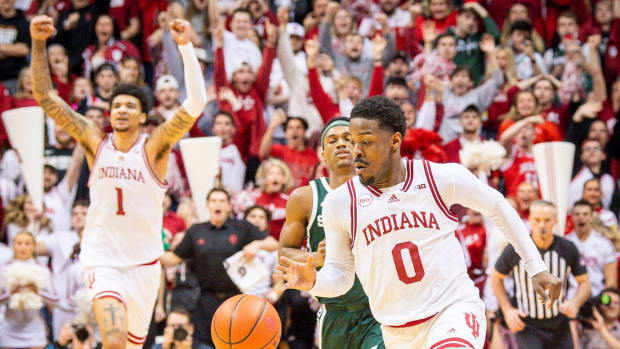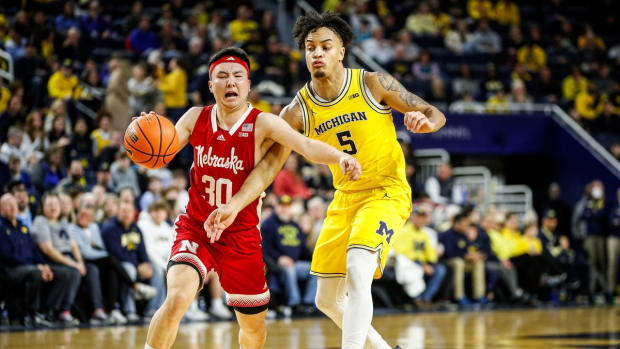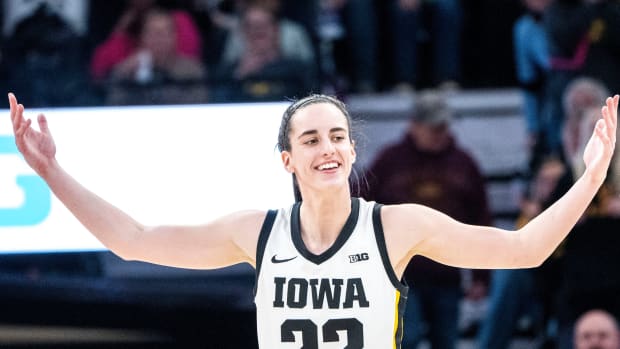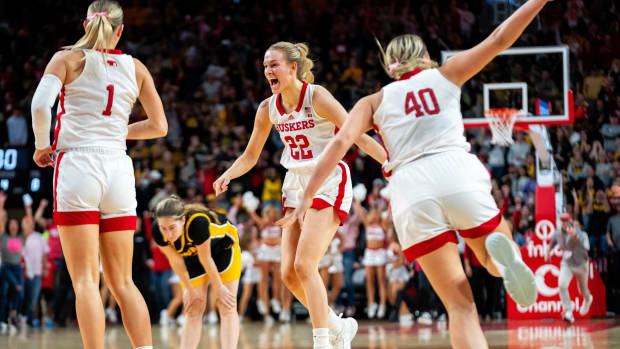Michigan Basketball: How To Use Advanced Analytics This Season
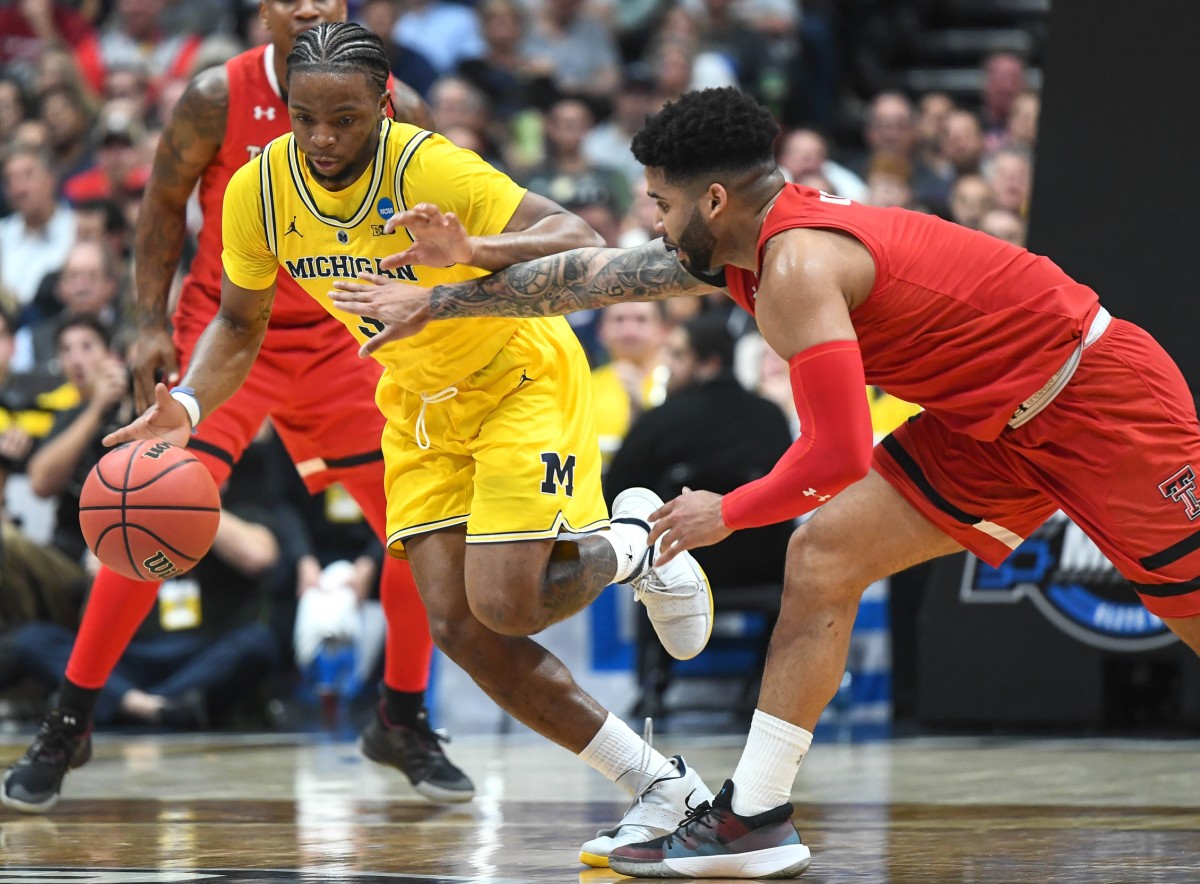
Statistical Analysis: A KenPom Primer
When Michigan takes the court for the first time under first-year head coach Juwan Howard tonight against Appalachian State, it will be without three of its biggest contributors from a year ago. Gone are Ignas Brazdeikis, Charles Matthews and Jordan Poole—the team’s three-leading scorers in 2019, averaging a combined 39.8 points per game.
For Howard and his staff, the task of filling the void left by the early departures of the Wolverines’ top workhorses extends beyond simply production on the court.
According to basketball analyst Ken Pomeroy’s highly-regarded KenPom.com rating system, which keeps track of most frequent line-up combinations over the most recent five games, 80.6 percent of U-M’s lineups down the stretch last season included at least two of Brazdeikis, Matthews and Poole on the floor, and 43.0 percent of lineup combinations featured all three on the court at the same time.
• Poole finished 2019 ranked 11th in the Big Ten in Percentage of Minutes Played (%Min), which measures the amount of time a player saw the court against the total possible minutes he could have played, at 82.7%Min.
• Brazdeikis (74.2%Min, 29th Big Ten) and Matthews (72.3%Min, 35th Big Ten) each ranked among the top 35 in the conference in this category.
Every week during the 2020 season, we will be taking a deeper look into the trajectory of Michigan’s key performers using KenPom’s advanced statistical model. First, a (somewhat brief) primer on the system’s key individual metrics, and what the Wolverines will need to replace and have returning in each specific category.
Usage
Percentage of Possessions Used (%Poss) is an analytics-based look at a player’s role in an offense, focusing on the percentage of a team’s possessions a player is responsible for ending while he is on the floor. *Minimum 40%Min to qualify for conference rankings.
Based on this datapoint, players are then divided into five categories -- Major Contributors (24-28%Poss), Significant Contributors (20-24%Poss), Role Players (16-20%Poss), Limited Roles (12-16%Poss), and Bench Warmers (played in fewer than 10% of the team's total minutes).
Lost: In 2019, Brazdeikis was the only Wolverine, and only one of 20 Big Ten players, that qualified as Major Contributor with a 24.5%Poss (17th Big Ten), Matthews was U-M’s only Significant Contributor at 23.5%Poss (23rd Big Ten), and Jordan Poole was one of Michigan’s three Role Players at 20.0%Poss (42nd Big Ten).
Returning: Of returning players, both senior point guard Zavier Simpson (19.3%Poss, 46th Big Ten) and senior center Jon Teske (17.0%Poss, 61st Big Ten) held Role Player status in 2019, and junior forward Isaiah Livers (15.7%Poss, 71st Big Ten) and junior guard Eli Brooks (13.4%Poss, did not qualify for conference rankings) snuck into the Limited Role category.
Offensive Rating
Offensive Rating (ORtg) is derived from a complicated formula that KenPom uses to measure the overall offensive efficiency of a player. An ORtg of 110 is considered good and a ORtg of 120 or more is considered outstanding. *Minimum 40%Min to qualify for conference rankings.
Lost: Brazdeikis ranked third on the 2019 squad with a 110.7 ORtg (25th Big Ten), with Poole just a few points behind him at 108.2 (32nd Big Ten). Matthews finished at 98.0 (74th Big Ten).
Returning: According to KenPom, three of Michigan’s top-five most efficient offensive players that saw significant action will be back for the 2020 season. Livers paced the Maize and Blue with a 120.6ORtg a season ago (10th Big Ten), just ahead of Teske’s 120.1 ORtg (11th Big Ten). Simpson’s 108.2 ORtg was good for fourth on the team (35th Big Ten).
Brooks finished last among Wolverines that earned at least 12%Poss with a 94.1ORtg. In very limited sample sizes, senior center/forward Austin Davis registered a 107.5 ORtg and sophomore forward Brandon Johns clocked in at 102.8.
Four Factors
KenPom’s offensive efficiency data is based off of Four Factors that offer a statistical analysis of why a team or player is good or bad when they possess the ball.
Effective field goal percentage (eFG%) takes the traditional field goal percentage formula but gives 50% more credit for three-point makes. *Minimum 60%Min to qualify for conference rankings.
Lost: U-M will look to replace two of the Big Ten’s top 15 most efficient shooters in Poole (53.8 eFG%, 13th Big Ten) and Brazdeikis (53.1 eFG%m 14th Big Ten).
Returning: Livers tallied the team’s best eFG% at 61.8, but did not register the required %Min to qualify for KenPom’s Big Ten leaderboard. Teske finished 8th among qualified conference players with a 56.5 eFG%. Both Simpson (48.8 eFG%) and Brooks (44.9 eFG%) finished with below the 50.0 eFG% mark.
Turnover Rate (TORate) measures a player’s ability to take care of the ball by dividing turnovers committed over total possessions. A TORate under 15 for most positions is considered excellent, however 20-25 is considered good for point guards because they handle the ball more frequently than other players on the floor. *Minimum 40%Min to qualify for conference rankings.
Lost: Brazdeikis was top-five in the conference in TORate (10.5, 5th Big Ten), and both Matthews (13.9, 28th Big Ten) and Poole (14.3, 31st Big Ten) displayed above-average ball-security with sub-15 TORates.
Returning: Teske led the conference with a minuscule 6.3 TORate, and Livers’ 11.3 TORate ranked seventh in the Big Ten. Simpson’s 18.8 TORate was above average for a point guard according to KenPom, and Brooks finished with a TORate of 15.6. Ball security was an issue with backup big men, however with Davis (21.5), Johns (21.4) and sophomore center/forward Colin Castleton (17.5) each finishing with TORates north of 17.
Offensive Rebound Percentage (OR%) represents the number of offensive rebounds a player grabs against all possible offensive rebound opportunities, and Defensive Rebound Percentage (DR%) evaluates the same measurable but on the defensive end. For OR%, anything above 10 is considered above average and a DR% above 20 is considered good. *Minimum 40%Min to qualify for conference rankings.
Lost: On the offensive glass, none of Brazdeikis, Matthews or Poole topped the 10.0 OR% mark, with Matthews leading the group at 5.7 DR% (32nd Big Ten). Defensively, Brazdeikis was tops among the departed contributors with a 16.1 DR% (23rd Big Ten). Neither Matthews (12.6 DR%, 46th Big Ten) nor Poole (9.3 DR%, 72nd Big Ten) ranked inside the conference’s top 40.
Returning: As the tallest member of the squad, Teske predictably led key Maize and Blue performers on both ends of the glass with an 8.4 OR% (22nd Big Ten) and a 20.2 DR% (12th Big Ten). Livers represented the second-best rebounding production among returning players that played significant minutes last season with a 3.9 OR% (46th Big Ten) and 15.7 DR% (24th Big Ten). Castleton made the most of his time on the court, amassing an impressive 14.6 OR% and 22.4 DR% (did not qualify for conference rankings), both considered good by the KenPom metrics.
Free throw rate (FTRate) measure a player’s propensity to get to the foul line by tracking free throws attempted per 100 field goals attempts—a number above 50 is considered good, and a FTRate over 70 is outstanding. This is a key indicator because it is assumed that getting to the charity stripe often is the mark of an efficient offensive player. *Minimum 60%Min to qualify for conference rankings.
Lost: Brazdeikis (36.9 FTRate, 16th Big Ten), Matthews (34.9 FTRate, 21st Big Ten) and Poole (24.4 FTRate, 40th Big Ten) all cracked the conference’s top 40 in this statistical category.
Returning: Teske (34.6 FTRate, 23rd Big Ten) was the only Wolverine that ranked in the top 25 in the conference in 2019, with Simpson the only other returning player that qualified in the top 50 (19.3 FTRate, 48th Big Ten). Although he didn’t play enough minutes to qualify for KenPom’s Big Ten leaderboard, Castleton led U-M with a 40.0 FTRate a year ago.
Other Important Metrics
Assist Rate (ARate) represents the number of assists a player is credited against the field goals made by teammates. *Minimum 40%Min to qualify for conference rankings.
Lost: Poole (13.0 ARate, 42nd Big Ten) was one of only two Wolverines to rank inside the conference’s top 50 in this metric a year ago.
Returning: Simpson’s 36.4 ARate was good for best on the team and second-best in the Big Ten in 2019. Brooks compiled a 15.1 ARate last season, and sophomore point guard David DeJulius finished with a 9.1 ARate.
Block Percentage (Blk%) is the percentage of blocks on two-point shot attempts a player records. A Blk% of 8 or higher is considered above average. *Minimum 40%Min to qualify for conference rankings.
Lost: None of the three departing players recorded a significant Blk%, with Brazdeikis pacing the group at 1.7 Blk% (41st Big Ten).
Returning: Teske ranked fourth in the Big Ten with a 7.41 Blk% and Livers notched a 2.45 Blk% (29th Big Ten). Sophomore forward Colin Castleton boasted a respectable 6.3 Blk% in limited minutes, but did not play enough minutes to qualify for KenPom’s Big Ten player rankings.
Steal Percentage (Stl%) calculates the percentage of opponent’s possessions that a player registers a steal. A Stl% of 5 or higher is considered good. *Minimum 40%Min to qualify for conference rankings.
Lost: Howard’s defense will be without two of its top three most efficient pickpockets in Matthews (2.07 Stl%, 27th Big Ten) and Poole (2.01 Stl%, 31st Big Ten).
Returning: Simpson’s 2.59 Stl% was the best on the 2019 team and seventh-best in the conference. Both Livers (1.95 Stl%, 33rd Big Ten) and Teske (1.55 Stl%, 49th Big Ten) cracked the league’s top 50.
So What Does It All Mean?
As high-impact players move on, whether to the next level or by exhausting their eligibility, a program is dependent on developing younger players, alongside high-impact recruits, to fill the gaps left by departing players.
Highly-lauded freshman Franz Wagner will miss significant time early to start the season with a fractured wrist and it is still unknown how long it will take for fellow-frosh Cole Bajema to comfortably transition to the college game.
This means that the Wolverines will be heavily-dependent upon players like Livers, Simpson and Teske to continue their upward trajectory from a year ago, and several of last season’s lesser-utilized players like Brooks, DeJulius, Johns and sophomore guard Adrien Nunez need to effectively grow into larger roles to replace the production U-M lost over the summer.
The continued development of Castleton and getting quality minutes off the bench from Davis would also go a long way in providing Howard’s team quality depth down-low.
Simpson has seen a steady increase in usage as he has grown into the Wolverines’ floor general, moving from a Limited Role contributor in 2017 (14.6%Poss), to a Role Player in 2018 (18.8%Poss) and 2019 (19.3%Poss).
Teske, a Benchwarmer according to KenPom in 2017 with a 4%Min, elevated to Role Player in 2018 (16.6%Poss) and 2019 (17.0%Poss).
Both Livers and Brooks were classified as Role Players in each of the last two seasons, with Livers seeing a noticeable increase in usage from 2018 to 2019 (12.9%Poss in 2018, 15.7%Poss in 2019) while Brooks' usage actually decreased in the same timespan (14.9%Poss in 2018, 13.4%Poss in 2019).
Look for this trend to continue as the trio of upperclassmen will be heavily relied upon on both end of the floor this season.
While Michigan does return three of its top five most efficient offensive players according to KenPom’s ORtg, the returning and incoming freshman guards will need to elevate their eFG% to above 50.0 if they are going to fill in for the shooting efficiency lost in Brazdeikis and Poole.
Projected contributors in Brooks, DeJulius and Castleton will need to improve upon their below 100 ORtg, and Johns needs to show that his 102.8 ORtg in limited minutes can be sustained with more floor time.
Castleton recorded above average numbers in two of the Four Factors (OR%/DR% and FTRate), and continuing this positive trend in an increased role will help bolster U-M’s front court, particularly if Teske finds himself in foul trouble.
Rebounding will also be an area to keep an eye on, particularly on the offensive end, as Michigan did not boast a player in the top 20 in the Big Ten in OR%, and only Teske finished inside the top 20 in DR%.
Check back every week for an analytics-based look at the team’s progress and trajectory.

